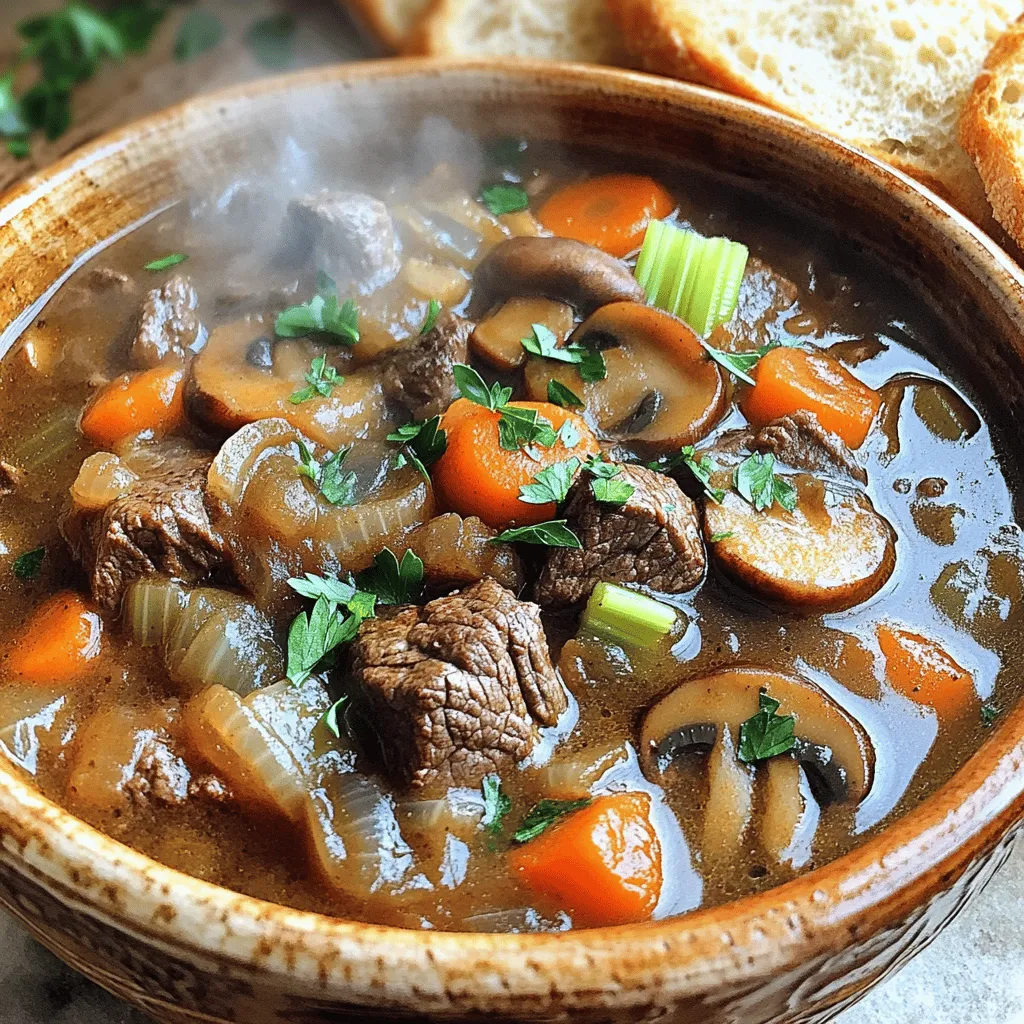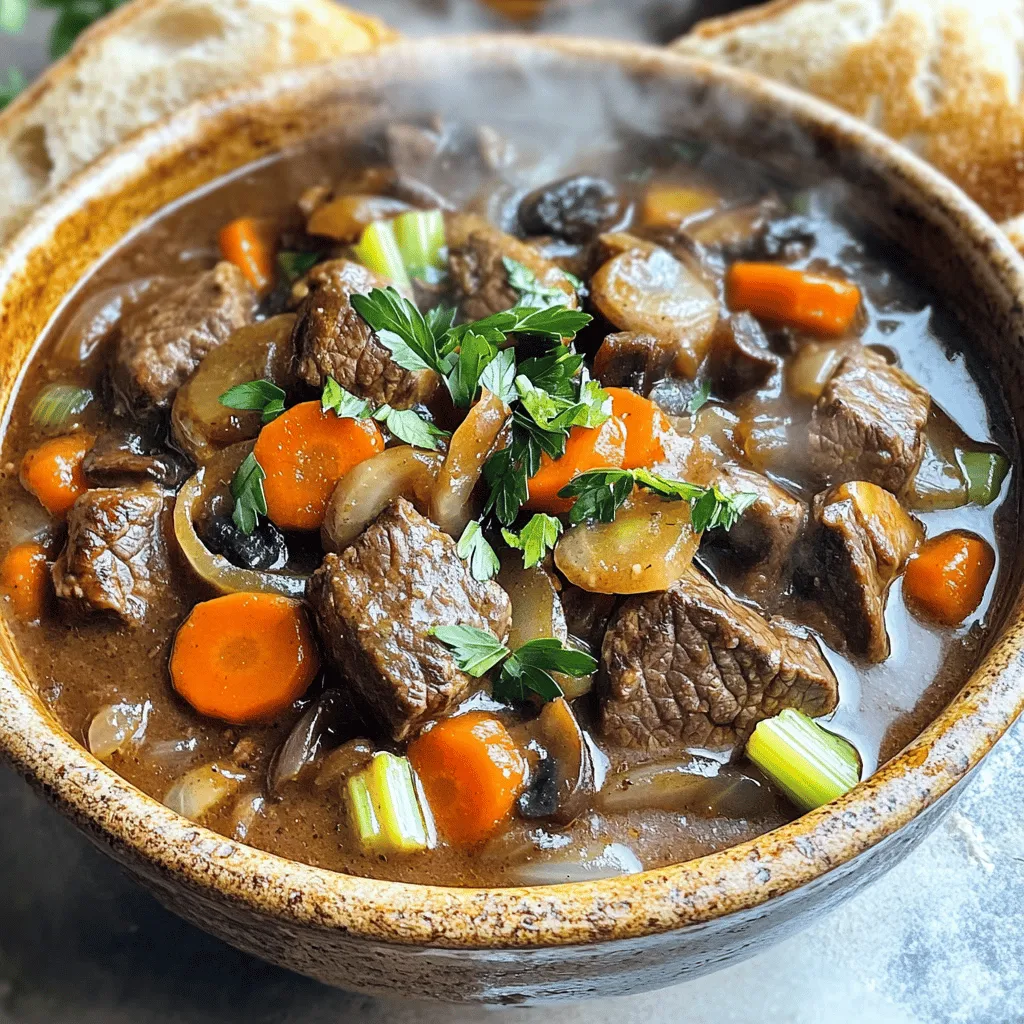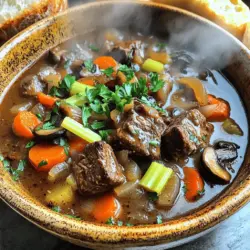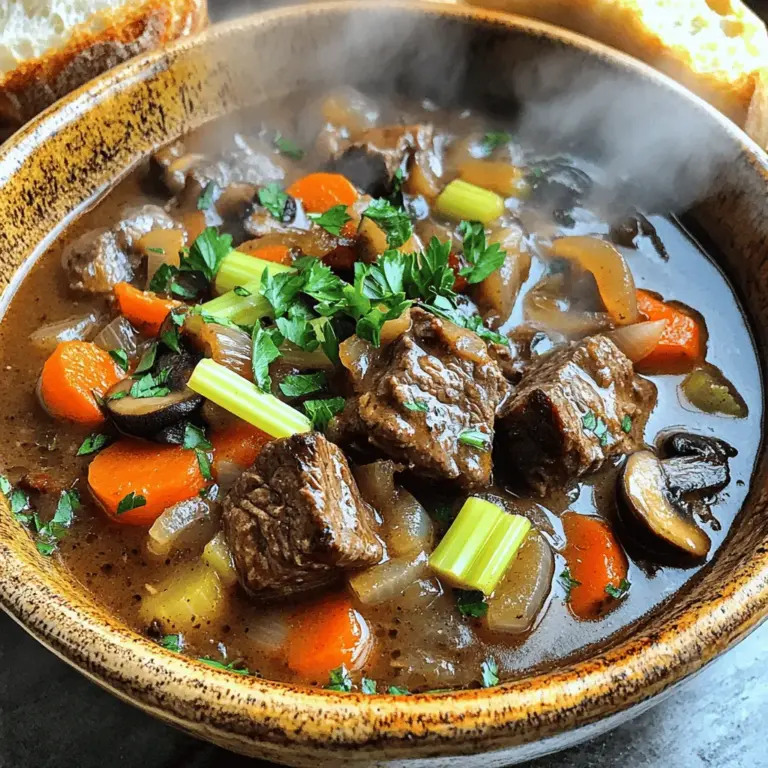Welcome to a savory journey through the world of Beef Carbonnade Stew! This hearty dish bursts with flavor and warmth, perfect for chilly nights. In this article, I’ll guide you through the essential ingredients, cooking steps, and unique variations to try. You’ll learn how to create a rich stew that blends traditional Belgian roots with delicious twists. Ready to savor every bite? Let’s dive into this culinary delight!
What Ingredients Do You Need for Beef Carbonnade Stew?
What are the essential ingredients for Beef Carbonnade Stew?
To make beef carbonnade stew, you need quality ingredients. Start with 2 pounds of beef chuck, cut into 1-inch cubes. This cut is perfect because it becomes tender with slow cooking. You also need 3 tablespoons of olive oil for browning the beef. Two large onions, sliced thin, add sweetness to the stew. Three cloves of garlic, minced, bring in a robust flavor.
Next, use 4 cups of beef broth to keep the stew moist. Balsamic vinegar adds a nice tang. One tablespoon of brown sugar balances the flavors. Dried thyme, bay leaves, and salt and pepper enhance the taste. For veggies, add 1 cup each of sliced carrots, diced celery, and sliced mushrooms. Lastly, chop fresh parsley for a bright garnish.
How do different cuts of beef affect the flavor and texture?
Choosing the right beef cut is key. Beef chuck is the best for stews. It has a good amount of fat, which adds flavor. As it cooks, the fat melts, making the meat tender. Other cuts like brisket can work too, but they may need more cooking time. Cuts like sirloin are leaner and can dry out. Always choose cuts that become tender with slow cooking.
What vegetables and spices complement the beef in this dish?
Vegetables add depth to the stew. Onions and garlic are must-haves for flavor. Carrots and celery bring sweetness and crunch. Mushrooms add earthiness that pairs well with beef. For spices, dried thyme and bay leaves are classic choices. They infuse the stew with a lovely aroma. You can also add a bit of crushed red pepper for heat, if you like. These ingredients come together to create a hearty and flavorful dish.
How Do You Cook Beef Carbonnade Stew Step-by-Step?
To cook carbonnade, start by heating olive oil in a large pot. Cut your beef chuck into 1-inch cubes. Season the beef with salt and pepper before browning it in batches. This step adds great flavor. Once browned, set the beef aside.
Next, add sliced onions to the pot. Cook them for about 10 minutes until soft and golden. Then, mix in minced garlic and cook briefly. This brings out a rich aroma.
Now, return the beef to the pot. Pour in beef broth, balsamic vinegar, brown sugar, thyme, and bay leaves. Stir well and bring the mixture to a simmer.
For the best flavor, you must let it simmer for 1.5 to 2 hours. This time helps the beef become tender and the flavors meld together. Stir in sliced carrots, diced celery, and mushrooms about halfway through.
For a tender and tasty stew, here are some tips. Use beef chuck for the best texture. Brown the meat well to create a deep flavor. Simmer on low heat to keep the stew from boiling. Adjust seasoning to taste before serving.
When ready to serve, remove the bay leaves. Ladle your stew into bowls and garnish with parsley. Serve this hearty dish with crusty bread or creamy mashed potatoes. This recipe is a true delight for any meal.

What Variations Can You Create for Carbonnade Stew?
You can adapt carbonnade stew to fit many tastes and diets. If you want a lighter dish, use chicken or turkey instead of beef. For a vegetarian option, try mushrooms and lentils. They add great texture and flavor.
Many cultures have their own versions of carbonnade. In France, they make a similar stew called boeuf bourguignon. This dish uses red wine for depth. In Germany, you might find a version with beer and sauerkraut. Each version brings a unique twist to the classic recipe.
When you compare carbonnade to other beef stews, you see key differences. Carbonnade often features beer, giving it a rich flavor. Other stews may use wine or broth. The choice of liquid really shapes the taste.
If you want to explore different beer styles, try a Belgian ale. It adds a sweet, malty note. You can also use stouts for a deeper flavor. Each beer choice makes the stew unique.
For popular variations, consider adding spices or herbs. Rosemary and thyme enhance the stew’s aroma. You can also add smoked paprika for a hint of heat. Each little change can make a big difference.Enjoy the process of making it your own!
What Are the Best Side Dishes to Serve with Carbonnade?
Serving beef carbonnade stew is a joy. This hearty stew pairs well with many sides.
What traditional sides pair well with this rich Belgian dish?
Classic sides include creamy mashed potatoes or buttered noodles. The stew’s rich sauce soaks into the potatoes. It adds depth to each bite. Another great choice is crusty bread. Use it to scoop up the stew.
How can you elevate your meal with modern side options?
For a twist, serve it with roasted vegetables. Carrots, Brussels sprouts, or asparagus add color and crunch. A fresh salad with a tangy vinaigrette also works well. It balances the stew’s richness.
What are some bread and vegetable pairings that complement Carbonnade?
You can pair carbonnade with sourdough or baguette. These breads have a nice texture for dipping. For vegetables, try green beans or peas. Their bright flavors contrast with the stew’s deep taste. For extra flavor, sauté the greens with garlic.
These side dishes truly enhance the experience of enjoying beef carbonnade. Each option brings a unique touch to this classic meal.

How Do You Enhance the Flavor Profile of Carbonnade?
To make your carbonnade shine, use the right spices and herbs. Thyme and bay leaves are essential. They add depth and warmth to the stew. I also like to use a touch of garlic. It brings a nice aroma that makes your mouth water.
What spices and herbs bring out the best flavors in Carbonnade?
The best seasonings for beef stew include thyme, bay leaves, and black pepper. You can also try adding rosemary for a fresh taste. A sprinkle of paprika can give it a slight kick. These spices work together to enhance the beef’s natural flavors. They create a rich and hearty meal.
How can beer selection influence the overall taste?
Beer is key in carbonnade. A dark beer like a stout or brown ale works best. It adds a robust flavor that complements the beef. The sweetness of the beer balances the stew’s savory notes. When you simmer the beef in beer, it tenderizes the meat and deepens the flavor.
Are there unique ingredients that can elevate the flavor?
You can elevate the dish with balsamic vinegar and brown sugar. Balsamic vinegar adds acidity, while brown sugar brings sweetness. Together, they create a great balance. Adding mushrooms can also give a savory umami flavor. Each ingredient plays a role in crafting that perfect flavor profile of carbonnade.
How Does Carbonnade Fit into Belgian Culinary Tradition?
Carbonnade holds a special place in Belgian cooking. This hearty stew dates back to the Middle Ages. It reflects the country’s love for rich, comforting dishes. Originally, people made carbonnade with whatever meat they had on hand. Today, we often use beef, which tenderizes well in a long cook.
What is the historical significance of Carbonnade in Belgium?
Carbonnade has a deep history in Belgium. It showcases the rustic style of Belgian cuisine. Farmers cooked it to feed their families. The stew is a simple mix of meat and local ingredients. This dish shows how people used what was available.
How is Carbonnade traditionally enjoyed during Belgian festivities?
During festivals, Belgians often serve carbonnade. It brings people together, creating a sense of warmth. Families enjoy it during colder months, especially around holidays. You may find it at fairs and local gatherings. It pairs well with good company and hearty bread.
What role does beer play in the cultural significance of Carbonnade?
Beer is key in carbonnade. Many recipes call for Belgian beer, adding rich flavor. The beer’s sweetness balances the meat’s savoriness, creating harmony. Different beer styles can change the dish’s taste and depth. This connection to beer shows how culture and food blend in Belgium. Enjoying carbonnade with a local brew is a true taste of Belgium.
Beef Carbonnade Stew shines through thoughtful ingredient selection and preparation. We explored essential ingredients, the impact of beef cuts, and the best pairings. Cooking step-by-step ensures a rich flavor and tender texture. You can also adapt the recipe for different diets and enjoy various cultural twists. Serve it with perfect sides and enhance flavors with spices and beer. Understanding its Belgian roots adds depth to your dish. This hearty stew is not just a meal; it’s an experience to share. Enjoy every bite of this classic!



